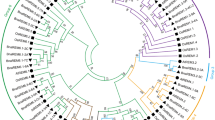Abstract
CUC2 encodes a NAC domain transcription factor required for establishing boundaries around plant organ primordia. It is also associated with the initiation of the shoot apical meristem. We cloned a 1497-bp BpCUC2 promoter fragment and constructed a pBpCUC2::LUC vector for birch transgenic. A quantitative real-time polymerase chain reaction (qRT-PCR) analysis of transgenic birch buds, leaves, stems, and roots revealed that luciferase (LUC) was most highly expressed in the buds. The pBpCUC2::LUC transgenic birch plants were treated with methyl jasmonate, indoleacetic acid, abscisic acid, or gibberellic acid3 for 2 h. The subsequent qRT-PCR analysis indicated that the transgenic birch tissues responded differently to the various hormones. Our results confirmed that BpCUC2 expression is influenced by hormones. The PLACE online tool revealed that the BpCUC2 promoter sequence contains several cis-acting elements. Furthermore, an auxin response element was used to screen transcription factors in a yeast one-hybrid assay. We identified three unique cDNA sequences, with complete open reading frames containing regulatory motifs, which were related to growth and development.







Similar content being viewed by others
Abbreviations
- CUC2 :
-
CUP-SHAPED COTYLEDON2
- SAM:
-
Shoot apical meristem
- BpCUC2 :
-
Betula platyphylla × Betula pendula CUC2
- pBpCUC2:
-
BpCUC2 promoter
- LUC :
-
Luciferase
- PINs:
-
PIN-formed proteins
- SD:
-
Synthetic dropout medium
- Leu:
-
Leudne
References
Aida M, Ishida T, Tasaka M (1999) Shoot apical meristem and cotyledon formation during Arabidopsis embryogenesis: interaction among the CUP-SHAPED COTYLEDON and SHOOT MERISTEMLESS genes. Development 126:1563–1570
Bilsborough GD et al (2011) Model for the regulation of Arabidopsis thaliana leaf margin development. PNAS 108:3424–3429
Butler JE, Kadonaga JT (2002) The RNA polymerase II core promoter: a key component in the regulation of gene expression. Genes Dev 16:2583–2592
Camoni L, Harper JF, Palmgren MG (1998) 14-3-3 proteins activate a plant calcium-dependent protein kinase (CDPK). FEBS Lett 430:381–384
Del VF, Casaretto JA, Quatrano RS (2007) 14-3-3 Proteins are components of the transcription complex of the ATEM1 promoter in Arabidopsis. Planta 227:167–175
Hasson A, Plessis A, Blein T, Adroher B, Grigg S, Tsiantis M, Boudaoud A, Damerval C, Laufs P (2011) Evolution and diverse roles of the CUP-SHAPED COTYLEDON genes in Arabidopsis leaf development. Plant Cell 23:54–68
Hay A, Barkoulas M, Tsiantis M (2006) ASYMMETRIC LEAVES1 and auxin activities converge to repress BREVIPEDICELLUS expression and promote leaf development in Arabidopsis. Development 133:3955–3961
Higo K, Ugawa Y, Iwamoto M, Korenaga T (1999) Plant cis-acting regulatory DNA elements (PLACE) database: 1999. Nucleic Acids Res 27:297–300
Ishida S, Fukazawa J, Yuasa T, Takahashi Y (2004) Involvement of 14-3-3 signaling protein binding in the functional regulation of the transcriptional activator REPRESSION OF SHOOT GROWTH by Gibberellins. Plant Cell 16:2641–2651
Jefferson RA (1989) The GUS reporter gene system. Nature 342:837
Koyama T, Mitsuda N, Seki M, Shinozaki K, Ohme-Takagi M (2010) TCP transcription factors regulate the activities of ASYMMETRIC LEAVES1 and miR164, as well as the auxin response, during differentiation of leaves in Arabidopsis. Plant Cell 22:3574–3588
Mu H, Lin L, Liu G, Jiang J (2013) Transcriptomic analysis of incised leaf-shape determination in birch. Gene 531:263–269
Nikovics K, Blein T, Peaucelle A, Ishida T, Morin H, Aida M, Laufs P (2006) The balance between the MIR164A and CUC2 genes controls leaf margin serration in Arabidopsis. Plant Cell 18:2929–2945
Popescu SC, Tumer NE (2004) Silencing of ribosomal protein L3 genes in N. tabacum reveals coordinate expression and significant alterations in plant growth, development and ribosome biogenesis. Plant J 39:29–44
Qu C, Bian X, Jiang J, Chen S, Liu G (2017) Leaf morphological characteristics and related gene expression characteristic analysis in Betula pendula ‘Dalecarlica’ and Betula pendula. J Beijing For Univ 39(8):9–16
Ramirez J, Bolduc N, Lisch D, Hake S (2009) Distal Expression of knotted1 in maize leaves leads to reestablishment of proximal/distal patterning and leaf dissection. Plant Physiol 151:1878–1888
Schmittgen TD, Livak KJ (2008) Analyzing real-time PCR data by the comparative CT method. Nat Protoc 3:1101–1108
Sonnewald U (1992) Expression of E. coli inorganic pyrophosphatase in transgenic plants alters photoassimilate partitioning. Plant J 2:571–581
Takada S, Hibara K, Ishida T, Tasaka M (2001) The CUP-SHAPED COTYLEDON1 gene of Arabidopsis regulates shoot apical meristem formation. Development 128:1127–1135
van Hemert MJ, Steensma HY, van Heusden GP (2001) 14-3-3 proteins: key regulators of cell division, signalling and apoptosis. Bioessays 23:936–946
Yang G, Chen S, Wang S, Liu G, Li H, Huang H, Jiang J (2015) BpGH3.5, an early auxin-response gene, regulates root elongation in Betula platyphylla × Betula pendula. Plant Cell Tissue Org 120(1):239–250
Yang G, Wang C, Wang Y, Guo Y, Zhao Y, Yang C, Gao C (2016) Overexpression of ThVHAc1 and its potential upstream regulator, ThWRKY7, improved plant tolerance of cadmium stress. Sci Rep 6:18752
Acknowledgements
This work was supported by the National Natural Science Foundation of China “Cloning and Functional Study on the Leaf Margin-related Genes of Betula platyphylla” Grant (Grant No. 31370660) and 111 Project (B16010). The funding source had no other involvement.
Author information
Authors and Affiliations
Contributions
CL, HX: performed all the experiments. SW assisted with DNA sequence analysis. GL, JJ together with CL, HX and SW designed the experiments and wrote the manuscript. All authors read and approved the manuscript.
Corresponding author
Ethics declarations
Conflict of interest
The authors declare that they have no conflict of interest.
Additional information
Communicated by John J Finer.
Electronic supplementary material
Below is the link to the electronic supplementary material.
Rights and permissions
About this article
Cite this article
Liu, C., Xu, H., Jiang, J. et al. Analysis of the promoter features of BpCUC2 in Betula platyphylla × Betula pendula . Plant Cell Tiss Organ Cult 132, 191–199 (2018). https://doi.org/10.1007/s11240-017-1324-2
Received:
Accepted:
Published:
Issue Date:
DOI: https://doi.org/10.1007/s11240-017-1324-2




